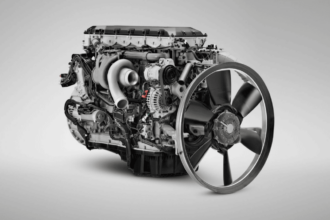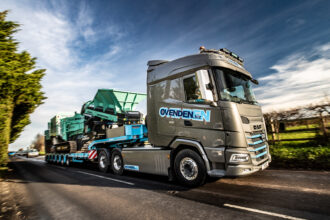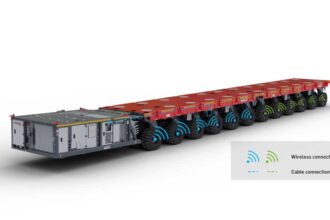THE EXPANSION OF THE ICE (INTERCITY EXPRESS) CONNECTION BETWEEN STUTTGART AND ULM INCLUDES THE ERECTION OF THE DOUBLE TRACK 485M-LONG FILSTAL BRIDGE OVER THE VALLEY NEAR MÜHLHAUSEN IM TÄLE. WITH A HEIGHT OF 85M AND IT WILL BE GERMANY’S THIRD HIGHEST RAILWAY BRIDGE.
The bridge is being constructed by the Max Bögl/Porr consortium and is the Deutsche Bahn AG’s largest single structure on the new ICE route, after the main railway station in Stuttgart. From 2022 onwards, high-speed trains will cross the bridge in just seven seconds at 250km/h.
The new Cometto MSPE self-propelled vehicles belonging to the Wiesbauer company moved the 350-tonne formwork carriage which up to now has bridged the distance from bridge pier to bridge pier and held the concreting formwork on the yellow booms.
While the traffic rolled below over the Drackensteiner Hang on the A8 towards Munich, the last preparations for this heavy duty transport were being made high above. “We illustrated each phase of the transport in advance in our schedule,” explains construction manager Daniel Welsch from Porr. “In doing so, we also determined the forces acting on the Cometto MSPE self-propelled vehicle.”
Since there is a permanent air stream in the valley, wind had to be taken into consideration. “And that’s where our engineers came into play,” says Joachim Kolb, Cometto’s sales manager. “In order to guarantee stability in all phases of the transport, calculations were made for wind speeds of 36km/h, 72km/h and, in case of a storm, 100km/h too.”
Since Wiesbauer, from Bietigheim-Bissingen, had been present on the building site for months with various mobile cranes, the company put in a bid for the execution of the heavy duty transport – and was awarded the contract. A novelty for Wiesbauer, which was thus active in the self-propelled vehicle sector for the first time and equipped itself for the task.
A total of 20 SPMT axle lines with an axle load of 48 tonnes and two power pack units with 202kW were ordered from Cometto in late 2019. And despite the serious effects of the corona pandemic, the vehicles arrived punctually for the important assignment on the bridge. “They’re celebrating their baptism of fire here,” said Jochen Wiesbauer, clearly enthusiastic about the new possibilities.
The formwork carriage was moved in an open compound. On one side two MSPE four-axle units from Wiesbauer in a side-by-side arrangement, on the opposite side – some 58m away – a six-axle MSPE, belonging to specialists from northern Germany Krebs Korrosionsschutz from Rostock, which was also called in.
For this specific case, the advance calculations had resulted in a maximum permissible lateral tilt of 4.58 per cent with a wind speed of 72km/h. In order to safely comply with these benchmark figures, the transport was moved forward by one day at short notice, because a storm front had been forecast, which could have endangered the procedure. Speed and precision were therefore called for in order to keep to the tight schedule.
The two transport managers, Jörg Neuhäusel from Krebs and Leonard Schmid from Wiesbauer, laid and programmed the data cable between the power pack units so that the entire vehicle group could be moved with just one radio remote control. In addition, they placed a guiding chalk line on the bridge along which the transport had to move with absolute precision.
At a speed of 0.5km/h, the group travelled from the Ulm side of the bridge over a distance of 485m towards Stuttgart. During the transport, the operator Neuhäusel, an expert from Krebs Korrosionsschutz, kept an eye on the transverse tilt: “At no time was 1.5 per cent exceeded – all safe!”.
Shortly before reaching the final position, the consortium had installed a cross-transfer track. At a later time, this will shift the formwork carriage into the position of the second bridge axis. And the first beam of this track now had to be overcome.
For that reason, a second Cometto SPMT combination with two six-axle bogies stood at the ready, likewise in a side-by-side arrangement. The obstacle run at a height began: the two four-axle bogies ‘handed over’ the load over the first cross-transfer track to the two six-axle units. As a result, the distance between the supports grew to a considerable 71.9m and the total weight of load and vehicles was around 438 tonnes.
After that, the combination proceeded further towards Stuttgart, the six-axle bogies being set back by 17.4m once again and, after moving the formwork carriage forwards again, set down on the second cross-transfer track. This took place with measurement of the position by the engineers on site.
Neuhäusel reduced the output of the power pack units to 20 per cent with the potentiometer on the remote control and moved the entire combination to the desired position. Mission accomplished!





